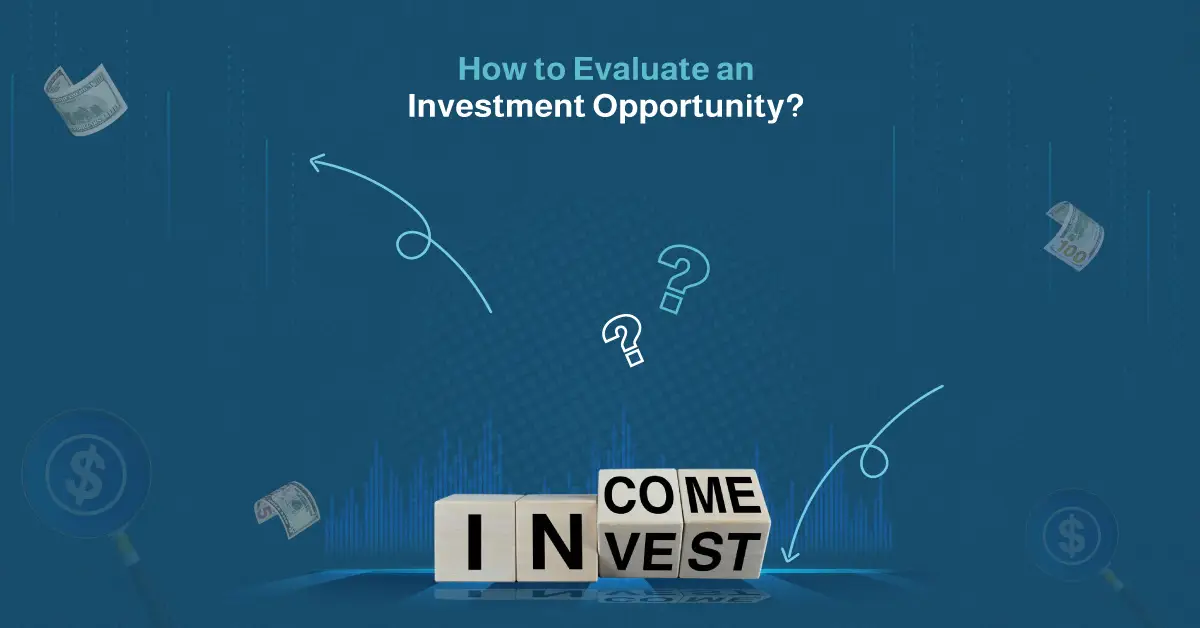While investing is a powerful way to build wealth, not every opportunity will turn out to be a golden egg. Knowing how to evaluate an investment opportunity will help you assess which opportunities are worth your time. This evaluation metric will assist you in making informed decisions that align with your financial goals, no matter whether you are new to investing or a seasoned investor with a diverse portfolio. The MENA and Saudi Arabian markets are shifting rapidly, meaning it is vital that you have an understanding of the fundamentals.
If an investment appears to be too good to be true, it is worth taking the time to scrutinize, as there may be hidden risks or limited returns. To avoid falling into a costly investment trap, several key factors should be considered: potential profitability, market trends, liquidity, and risk exposure. To avoid underperforming investments, it is wise to follow a structured approach that will allow you to identify opportunities that are best suited to your financial goal, time horizon, and risk tolerance.
In this guide, we will cover practical, step-by-step insights into how to evaluate an investment opportunity effectively. You will learn about key financial metrics, such as ROI, NPV, IRR, and payback period, how to assess risk, and common pitfalls to look out for. We will also explore how platforms like Gamma Assets make real estate-backed investments accessible, allowing you to diversify your portfolio and manage risk with minimal capital. By the end of the article, you should have a better understanding of how to evaluate an investment opportunity effectively using a clear framework and the confidence to act while making smarter decisions.
You can start investing now from the Gamma Asset Investment Platform
Understanding What Makes an Investment Opportunity Viable
What is it that makes an investment viable? Understanding this is the first step in learning how to evaluate an investment opportunity. A viable investment is an investment that promises potential returns while aligning with your financial goals, risk tolerance, and time horizon. Without this, even a profitable investment may not serve its purpose in your portfolio. There are several criteria to consider:
-
- Potential Returns: The investment should offer realistic prospects for growth or income. We are not suggesting that you begin chasing the highest returns, but rather look for steady, sustainable returns.
- Risk Profile: It is a known point that every investment opportunity carries some degree of risk. The risk can be from market fluctuations, regulatory changes, or liquidity issues.
- Liquidity: Relates to the speed at which you can get your money out of the investment. Some assets, such as listed stocks, can be sold quickly, while others, such as real estate, may take longer to get your capital out. Liquidity is important when your plan relies on flexibility.
- Market Demand and Timing: Even the strongest assets can underperform when market conditions are unfavourable. Understanding the economic climate in Saudi Arabia and the MENA region can help investors make smarter choices.
- Exit Strategy: Every plan should have an exit strategy to ensure you aren’t locked into an asset longer than you intend.
Let’s look at a comparison: buying shares in a fast-growing tech startup versus investing in a real estate-backed fund. While both have potential, the startup carries higher volatility and less liquidity. Real estate typically offers steadier, long-term returns. Weighing up the trade-offs and choosing the best path is easier when you know how to evaluate an investment opportunity.
Key financial metrics: ROI, NPV, IRR, and payback period
When learning how to evaluate an investment opportunity, you must gain an understanding og the numbers behind it. Using financial metrics, you can compare your options objectively, allowing you to make informed decisions. The four most used metrics include Return on Investment (ROI), Net Present Value (NPV), Internal Rate of Return (IRR), and Payback Period. Each provides a different perspective on the profitability and the timing of returns.
Here is a breakdown:
| Metric | What it measures | Formula/Calculation | Example |
| ROI (Return on Investment) | Percentage gain or loss relative to cost | (Gain – Cost) Cost 100 | Invested 10,000 SAR, Earned 1,500 SAR ROI =15% |
| NPV (Net present Value) | Value of Future cash flows discounted to today | (Cash Flow (1+r)t- initial investment | 10,000 SAR investment, discounted cash flows = 11,200 SAR NPV = 1,200 SAR |
| IRR (Internal Rate of Return) | Rate of return where NPV equals 0 | Solve for rin the NPV formula | Investment of 10,000 SAR has an IRR of 12% |
| Payback Period | Time to recover the initial investment | Initial Investment Annual Cash Flow | 10,000 SAR investment, 2,500 SAR yearly 4 years. |
Each of the above metrics offers valuable insight. ROI is simple and shows quick profitability, while NPV highlights whether future returns justify today’s costs. IRR is useful for comparing projects with different cash flow patterns, and the payback period reveals how long it takes to recover your money. This is a priority for most risk-conscious investors.
To look at an example, if two investments each promise 15% ROI, but one has a higher NPV and shorter payback period, it is likely to be the stronger choice. It is for this reason that investors need to do their due diligence and look beyond surface-level returns. With a mastery of these metrics, you will know how to evaluate an investment opportunity with confidence and accuracy.
Risk assessment and market considerations
Looking at potential returns is only half the picture when deciding how to evaluate an investment opportunity. Understanding the risk associated with the investment will help investors avoid unexpected losses.
The most common of these are:
- Market Risk: The chance that broader economic changes will reduce the value of your investment.
- Liquidity Risk: Some assets, such as real estate or private equity, might be more challenging to sell quickly when cash is needed.
- Inflation Risk: Over time, rising prices can erode the real value of returns.
- Regulatory Risk: Shifts in laws, taxes, or government policies can impact performance.
Market conditions should be considered alongside the risks. For example, in Saudi Arabia, economic growth and infrastructure investment have created strong opportunities in real estate. Timing is important; an attractive asset purchased in the wrong market phase can underperform. Weighing up the risks against potential returns while considering the market as a whole will allow you to have a clearer or realistic picture of the available opportunities. Getting this balance right is important for any investor learning how to evaluate an investment opportunity and make decisions that will support long-term financial success.
Common mistakes to avoid when evaluating investments
Mistakes can be made by anyone, no matter if you are a new or a seasoned investor. By recognizing the common pitfalls, you can ensure that you make more informed decisions when learning how to evaluate an investment opportunity.
As we have mentioned, a common mistake is to focus solely on high returns without considering the associated risks. A project may promise exceptional gains but carry hidden volatility or long-term uncertainty. Similarly by ignoring the market conditions, such as economic trends or regulatory changes, can lead to investments that do not perform well despite appearing promising.
Neglecting liquidity is another common pitfall. An asset that cannot be sold quickly may trap capital when you require flexibility. Overlooking fees, taxes, or exit costs also reduced overall profitability. Emotional decision-making should be avoided at all costs; chasing hype, following trends, or reacting to fear all lead to poor choices.
Try not to rely too heavily on a single metric; this is an error often made by beginners. It is important to consider the full picture, which includes NPV, IRR, and payback period. Using multiple metrics will provide you with a comprehensive framework that prevents narrow evaluations. By remaining disciplined, conducting thorough due diligence, and maintaining a long-term perspective, investors can avoid these common mistakes. Understanding these mistakes is a vital step in learning how to evaluate an investment opportunity and building a resilient, successful portfolio.
How Gamma Assets offers accessible real estate-backed investment alternatives
For investors looking for lower-risk, diversified options, Gamma Assets provides a practical solution. With real estate-backed opportunities starting from as little as 500 SAR, individual investors can assess professionally managed assets all from the comfort of an easy-to-use dashboard. This platform allows small to mid-sized investors to diversify their portfolios, balance risk, and benefit from steady returns. Platforms like Gamma Assets simplify entry into real estate markets while making it easier to apply lessons in how to evaluate an investment opportunity and gain exposure to tangible, long-term assets.
Learning how to evaluate an investment opportunity requires balancing potential returns, risk, liquidity, and market trends. Making use of these financial metrics, avoiding common mistakes, and exploring accessible platforms like Gamma assets will ensure you are well-equipped to make informed, confident decisions. Mastering how to evaluate an investment opportunity is key to growing wealth sustainably and achieving long-term financial goals.
More topics can be read on the Gamma blog
FAQ
What are the most important factors to consider when evaluating an investment opportunity?
The key factors are returns, risks, liquidity, and market conditions. Returns indicate whether an investment aligns with your financial goals. Risk assessment helps you understand potential losses and prepare accordingly. Liquidity shows how quickly you can access your funds, which is essential for flexibility. Finally, analyzing market trends, especially in Saudi Arabia and the MENA region, can highlight the long-term viability of the investment. Considering these together gives a balanced view of any opportunity.
How can beginners assess the risk of a new investment?
Beginners should research thoroughly, review historical performance if it is available, and diversify to spread risk. Scenario planning, considering best and worst case outcomes, can clarify potential exposure. Starting smaller, real estate-backed investments can also reduce risks while gaining practical experience.
Can small investors access high-quality investment opportunities?
Yes, platforms like Gamma Assets allow small investors access to real estate-backed investments with modest amounts, offering diversified, professionally managed assets. This allows gradual portfolio growth while controlling risk.













